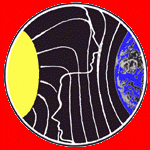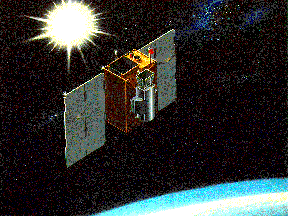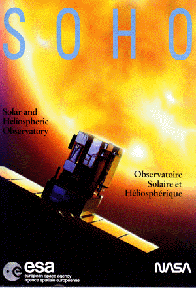
The History of Cosmic Ray Studies
1990 - 1999
- 1990s
 Since the 1980s, the collaborative efforts by NASA, the European Space Agency (ESA), and the Institute of Space and Astronautical Science (ISAS) of Japan led to the International Solar-Terrestrial Physics (ISTP) Science Initiative, a set of missions to be carried out during the 1990s and into the next century.
Since the 1980s, the collaborative efforts by NASA, the European Space Agency (ESA), and the Institute of Space and Astronautical Science (ISAS) of Japan led to the International Solar-Terrestrial Physics (ISTP) Science Initiative, a set of missions to be carried out during the 1990s and into the next century.- 1990
 Ulysses spacecraft was launched - USA & Europe solar flyby - It is part of an international project to study the poles of the Sun and interstellar space above and below the poles.
Ulysses spacecraft was launched - USA & Europe solar flyby - It is part of an international project to study the poles of the Sun and interstellar space above and below the poles.- 1991
- Yohkoh spacecraft launched - Japan/USA/England solar probe - studied high-energy radiation from solar flares.
- 1991
- Scientists at the University of Utah observed a cosmic ray event
with an energy of 3 x 1020 eV. Events with energies of
1020 eV (well above the GZK cut-off) had previously been
reported, but this was the most energetic.
- 1992
 The SAMPEX (Solar Anomalous and Magnetospheric Particle Explorer) mission was launched. It carries instruments in a polar orbit around the Earth, sampling both interplanetary and magnetospheric particles every orbit. These studies contribute to understanding the process of nucleosynthesis. They allow examination of the history and evolution of the galaxy and the solar system, as reflected in their composition, and aid in understanding the acceleration of particles on a variety of scales.
The SAMPEX (Solar Anomalous and Magnetospheric Particle Explorer) mission was launched. It carries instruments in a polar orbit around the Earth, sampling both interplanetary and magnetospheric particles every orbit. These studies contribute to understanding the process of nucleosynthesis. They allow examination of the history and evolution of the galaxy and the solar system, as reflected in their composition, and aid in understanding the acceleration of particles on a variety of scales.- 1992
 The IMAX (Isotope Matter-Antimatter eXperiment) balloon-borne superconducting magnet spectrometer was launched. It measured galactic cosmic ray abundances of protons, anti-protons, hydrogen, and helium isotopes.
The IMAX (Isotope Matter-Antimatter eXperiment) balloon-borne superconducting magnet spectrometer was launched. It measured galactic cosmic ray abundances of protons, anti-protons, hydrogen, and helium isotopes.- 1993
- Outburst of a supernova in the M81 galaxy in Ursa Major.
- 1994
 The Wind spacecraft was launched, as part of the ISTP project, to provide plasma, energetic particle, and magnetic field data on Earth's magnetosphere and solar wind.
The Wind spacecraft was launched, as part of the ISTP project, to provide plasma, energetic particle, and magnetic field data on Earth's magnetosphere and solar wind.- 1995
 SOHO (Solar and Helispheric
Observatory) spacecraft was launched - Europe/USA solar probe - The
observatory is studying the physical processes taking place in the
Sun's corona and changes in the Sun's interior by conducting remote
sensing observations in visible, ultraviolet and extreme ultraviolet
light. SOHO will be put into a "halo orbit"around the L1 libration
point, like ACE.
SOHO (Solar and Helispheric
Observatory) spacecraft was launched - Europe/USA solar probe - The
observatory is studying the physical processes taking place in the
Sun's corona and changes in the Sun's interior by conducting remote
sensing observations in visible, ultraviolet and extreme ultraviolet
light. SOHO will be put into a "halo orbit"around the L1 libration
point, like ACE.- 1995
- Physicists at CERN were able to force a positron to stick to an
antiproton, creating the first antihydrogen atom.
- 1995
- Design began on the Pierre Auger Project, a new cosmic ray
observatory name for the discoverer of air showers. The observatory in
Argentina uses a giant array of 1600 detectors to measure air showers
from ultra-high energy cosmic rays. Ground was broken in 1999, and
cosmic rays were first detected in 2001.
- 1996
 The Polar spacecraft was launched by NASA
from Vandenberg AFB in California on for the start of a planned
three-year mission. It performs simultaneous coordinated
measurements of the key regions of Earth's space environment with
other spacecraft to measure solar wind properties.
The Polar spacecraft was launched by NASA
from Vandenberg AFB in California on for the start of a planned
three-year mission. It performs simultaneous coordinated
measurements of the key regions of Earth's space environment with
other spacecraft to measure solar wind properties.- 1997
- Scientists discovered a "fountain" of antimatter near the the center
of the Milky Way
- 1997
- The Mars Global Surveyor space probe entered Mars' orbit and detected
a planetary magnetic field.
- 1997
- Scientists using the Solar and Heliospheric Observatory (SOHO)
spacecraft discovered "jet streams" or "rivers" of hot charged plasma
flowing beneath the surface of the Sun.
- 1997

NASA's Advanced Composition Explorer (ACE) spacecraft was launched. Real-time data from ACE are incorporated into the daily space weather forecasting system, and NOAA's Space Environment Center uses data from this system to track solar disturbances.
Back to main history page






Click on images above to
learn more about them
A service of the Heliophysics
Science Division at NASA's GSFC
Questions and comments to: cosmicopia@cosmicra.gsfc.nasa.gov
Curator: Dr Eric R. Christian, NASA
Responsible NASA Official: Dr Eric R. Christian
Privacy Policy and Important Notices
Questions and comments to: cosmicopia@cosmicra.gsfc.nasa.gov
Curator: Dr Eric R. Christian, NASA
Responsible NASA Official: Dr Eric R. Christian
Privacy Policy and Important Notices

HOME
In the News
History
Ask Us
Great Links
Glossary
Site Map
Search NASA